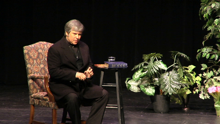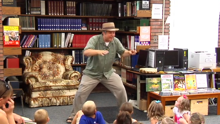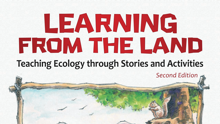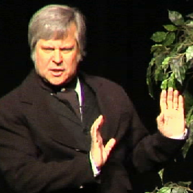-
Cherry, L. (1990). The Great Kapok Tree. New York: Harcourt Brace Jovanovich.
-
Deedy, C.A. (1991). Agatha's Feather Bed. Atlanta, GA: Peachtree.
-
Ellis, B. (1997). Learning from the Land: Teaching Science Through Stories and Activities. Englewood, CO: Teacher Ideas Press.
-
Ellis, B. (2006) THE WEB at Dragonfly Pond, Nevada City, CA: Dawn Publications
-
Frasier, D. (1991). On the Day You Were Born. New York: Harcourt Brace Jovanovich.
-
Haven, K. (1994). Marvels of Science; 50 Fascinating 5-Minute Reads. Englewood, CO: Libraries Unlimited.
-
Leopold, A. (1970). A Sand County Almanac. New York: Ballantine Books.
-
Muir, J. (1994). The Wild Muir. Yosemite, CA: The Yosemite Association.
-
Reed-Jones, C. (1995). The Tree in the Ancient Forest. Nevada City, CA: Dawn Publications.
-
Yolen, J. (1987). Owl Moon. New York: Philomel Books.
Join Our Mailing List
The Cottonwood
Or How I Learned The Importance Of Storytelling In Environmental Education
By Brian “Fox” Ellis
Most would agree that storytelling is one of the most important tools for teaching science and ecology. If you think about it…What is science? Science is an attempt to understand the story of the universe, ecology is the story of our home.
A well-told science story does three important jobs: It brings facts to life. It makes abstract concepts concrete. And through the virtual reality of storytelling, it walks listeners through the process approach to scientific inquiry.
I love all the amazing bits of intriguing information, science facts. And kids do too, if they’re presented in an intriguing way. Did you know the pronghorn antelope can run at speeds of 60 miles per hour? (kilometers?) Why? There are no predators in North America that even approach that speed. But if you stop with facts you are not teaching science. Science should be a verb, an activity, not simply a body of knowledge.
By concepts, I mean theories, the big picture ideas like the food web, evolution, the water cycle and animal adaptation. These concepts are critical to the understanding of modern ecology. With pronghorn antelopes, my guess would be that their speed is developed because of the concept of co-evolution, faster predators put pressure on prey to become faster in order to survive.
But if you stop with concepts, you still are not teaching science. You are building a necessary conceptual framework for the ordering and understanding of facts. Again, science is something you do, a way of asking questions and seeking answers.
Science process skills are the methods that scientists employ to discover the story of the universe. By asking good questions, formulating an hypothesis, designing an investigation, collecting data, analyzing and reordering data and drawing conclusions, you are engaged in scientific inquiry.
How could I prove my theory about pronghorn antelopes? What kind of investigation could I design to test their speed versus the speed of North America’s fastest predators?
A good story involves the listener in many of these same strategies: gathering the facts of the story, making predictions about the outcome, and checking their hypothesis against the unfolding details of the tale. Also, you can employ a story to make abstract concepts personal and tangible. You can convey important facts within a dynamic context so the facts stick; they have more meaning and impact.
Let me share a short story that will show you what I mean:
When I was a student at Oberlin College, one of my favorite biology professors was a man whom I only remember as George. At 94 years of age, he still taught an occasional class. His father, too, had been a biology professor at Oberlin College. He spent his entire life studying the flora and fauna of Northeastern Ohio. Botany was his specialty and he knew every plant on campus on a first name basis.
On Sunday afternoons, George led a hike in the arboretum. He meandered through the arboretum telling stories about whatever plant caught his fancy. One afternoon as we were walking in the flood plain of Plum Creek, he stopped next to an ancient cottonwood. This huge tree was almost a meter wide and maybe thirty meters tall. He leaned against this giant tree and said…
When I was a little boy, seven years old, my father told me that cottonwood trees had a unique characteristic: If you break off a branch and stick it in the mud it will sprout.
When my father told me this I thought, "Poppycock! If you break off a branch it is dead. A dead stick will not sprout." Note that I did not say this; I have more respect for my father than to openly dispute him without a bit of evidence, but I did not believe him.
Well, a few weeks later I was walking through the arboretum when a huge storm blew in. I love those Mid-western summer thunderstorms. As the clouds roll across the Great Lakes they pick up steam, literally. Most kids might run home, but not me. I love the crack of lightening, the roar of thunder, and the warm rains that pummel the earth.
As I was walking along Plum Creek a strong gust of wind snapped off a branch from a cottonwood tree and it stuck in the mud. I thought, "Aha! This is my chance to prove my father wrong." I came back each day for five days to gather evidence. Sure enough, after the third hot summer day it started to wilt. Because of the heat it was losing more water than it could absorb; evapo-transpiration is the scientific word for tree sweat. By the fifth day the leaves were curled. This branch was dead.
I went home and told my father he was wrong, and I had the proof. I was a precocious child…and my parents encouraged my inquisitive nature. My father calmly listened to my interpretation of the facts. He said, “Son, you’re jumping to conclusions. You need to collect more data.” He told me to go back to that tree every day for the next ten days, write down what I saw, and then to tell him what I thought. Being a good son, and wanting to be a good scientist, I went back to that stick every day for ten days.
Sure enough, after five more days the leaves started to uncurl. After seven days they started to plump up. By the tenth day the stick was indeed alive. I wanted to know why, so I carefully dug down around one side of the stick. I saw small roots that had begun to grow. So, my father was right. Cottonwood does have a unique characteristic, if you plant a stick in wet earth it will sprout. It's called regeneration. This is why cottonwood and willow are very important in preventing erosion. Streamside stabilization projects use willow posts and cottonwoods to help hold the stream banks in place.
I'll never forget this idea because, you see, this giant cottonwood tree that we are standing next to is that cottonwood stick I watched wilt 87 years ago. Obviously, my father was right because that stick has grown into this huge tree.
And now having heard the tale, you will never forget this concept either.
While the story is still fresh in your mind, make a short list of some of the facts you learned from this story. And which major concepts stand out for you? What are the science process skills modeled in this study of the cottonwood?
Through George's inquiry approach we have collected data about transpiration, root growth and regeneration. We have formulated the hypothesis that sticks cannot regenerate and then designed an investigation to prove or disprove our theory. We have drawn an incorrect conclusion and collected more evidence to discover the truth. We have learned about trees but more importantly we have learned the process skills we need to learn about the unfolding drama that is the story of the universe.
To paraphrase an old proverb, we have been given fish for supper and a net for catching all the fish we desire. Stories can make abstract theories concrete by bringing the listener into direct experience with the concept. The food web is not just an idea in a textbook; it is what you had for lunch. The water cycle flows through your blood streams.
Storytelling engages listeners in the scientific process through the suspense and virtual reality that a good story creates. Students get to make discoveries along with the author or main character in the tale. You can tell stories from your life and experience, or you could dramatize important discoveries in the history of science. Even works of realistic fiction, if grounded in good science, can be written or told to illuminate a concept, introduce a chapter, or prepare students for a science experiment.
After having said all that, I’ll say something more: If you stop here it isn't enough.
It is necessary for students to be energetically engaged in the activity of designing investigations and conducting research. After listening to this story about the cottonwood, what questions does it raise for you? How could you design a study that would find the answers? Go ahead and conduct this investigation. Remember: Science should be a verb!
After a recent retelling of this story one of the students' hands shot into the air immediately. When called upon he asked if this ability to regenerate was true of other trees. I asked what he thought. Several students' hands shot up. They discussed different trees that might regenerate. One child said, "We could plant sticks from different trees and see if it was true."
This is the other important role of storytelling in environmental education. A good story can motivate listeners or readers to want to become ecologists. Think about it…Who were the professors or teachers who inspired you to pursue this field? I'll bet they were all good storytellers.
What are your stories? How can you share your discoveries in a way that could inspire and instruct your students? What are some of the classic tales of ecology that you remember from your education?
One of my favorite stories from history is John Muir’s “Interview with a Bear.” He had heard that bears were afraid of humans and wanted to prove the theory. When he encountered a bear in Yosemite Valley he tried to scare it away but it was he who took off running in the end! His experiment failed, but we learned about bear ecology and “the experimental method,” a willingness to question the facts. Another of my favorite stories is about a woman’s love for butterflies and moths. Gene Stratton Porter conducted a thorough investigation for her book “The Moths of the Limberlost,” a classic work in field entomology. She learned that the diversity of insects is directly related to the health of the forest. She had a miraculous encounter with moths one night that left me breathless and inspired when I read of it. These are just two examples of classic tales you could tell.
In any discipline from astrophysics to molecular biology there are great stories about the scientists and their discoveries that you could dramatize. Environmental education is blessed with some of the best writers in American Literature: Ralph Waldo Emerson, Henry David Thoreau, Walt Whitman, Aldo Leopold, Rachel Carson, Annie Dillard, Gretal Ehrlich, Barry Holsten Lopez and the list goes on…
If you want to invigorate your classroom or guided hikes then tell stories to your students. And then inspire them to add their voice to the chorus to deepen our understanding of science, the story of the universe.
WHAT MAKES A GOOD SCIENCE STORY
The most important ecologists have all been good storytellers. Think about the scientists who have had the most lasting contributions to our understanding of scientific principles and the way things work. They have all been great writers and storytellers.
I believe that Rachel Carson changed the world in the first few pages of her landmark book "Silent Spring." Her modern parable about pesticides and the absence of songbirds in the spring helped to write new laws and radically transformed our relationship with the wild world. Her story took you inside the dilemma of a toxic environment and the long-term implications of what was then acceptable behavior. Her story, like the writings of Stephen J. Hawkins, Stephen Gould, Annie Dillard, Aldo Leopold, and others, can give you a front-row seat on scientific discoveries.
Through their stories you feel like a voyeur, looking over their shoulders as they fumble through their mistakes and stumble upon the truth. A good science story needs this sense of immediacy, this in-the-moment insider's view. Think about some passionate moment in your work as a scientist or science teacher. This passion and enthusiasm is important to the writing and telling of the tale. Like all good stories you need well-defined characters. Who was there? Help us get to know something about these people and their motivations. You need a clear setting. Where were you? Describe the place using all of your senses; take us into this unique moment and specific location. You also need a dynamic plot with a sense of mystery or surprise. What happened? What led to your discovery? What did you learn from your mistake or success? Take us step by step through the questions that lead to the research, the methods you used, and your Aha! moment, when things clicked for you. Let the reader or listener share your sense of discovery.
Use this outline to build your tale. Recreate the moment.
Exercise your science vocabulary while defining terms with explanatory clauses. If young kids can memorize the Latin names of dinosaurs they can certainly learn science vocabulary if they hear the words in a meaningful context. The truth is they will never learn these words unless they hear them in a meaningful context.
Interrupt the story to ask questions, engage the audience as guinea pigs in your experiment, or have the audience members choose a partner and tell each other their hypothesis.
When the story is over create a space for them to process the ideas, ask questions about the outcome, and internalize the concepts. Challenge them to design and conduct follow-up studies.
If the story motivates students to be active participants in scientific inquiry you know you have a great story!
HOW TO TELL A TALE
Think about storytellers you have seen. What do they do to bring the story to life? Who were your favorite professors, teachers, preachers and politicians? What techniques did they employ to hold your attention, to make ideas come to life?
Different personalities tell stories differently. The most important thing is to find a presentation style that suits your personality. With this said there are a few general techniques to consider:
Use your VOICE to create characters, express emotions, and experiment with pacing, tone, accents and sound effects. Use your BODY language, facial expressions and gestures to convey the unspoken and reinforce the words you are speaking. Use your IMAGINATION and all five senses to be in the tale as you tell it. The more real you can imagine it, the more real it becomes for your audience, even if it is a work of fiction. Involve the AUDIENCE with simple rhetorical questions or complex sing-a-long songs. Within the body of the story allow them a chance to discuss a prediction or formulate a hypothesis.
Engage the audience as a partner in the telling of the tale. Use your voice, body, imagination and the audience to tell, not read, the story.
Beyond technique, the most critical element is your passion for the content. If you can tell the story in a manner that conveys this excitement your contagious enthusiasm will be the key to a successful telling.
A Few of my favorite story sources:









